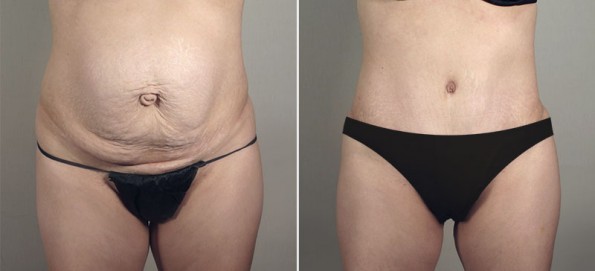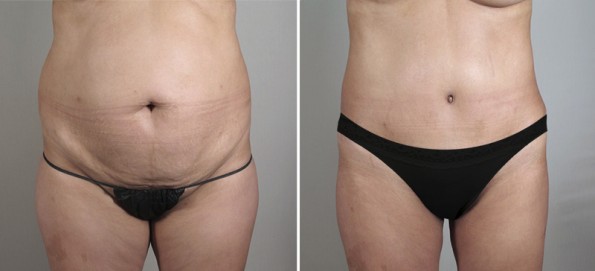Did you ever wonder what goes into creating a really beautiful tummy tuck result?
We recently interviewed Dr. Parker, whom we consider an authority on tummy tuck surgery—he’s performed thousands of procedures with beautiful results. He shared with us fascinating details about techniques he uses to help reduce post-op discomfort, lower risk for unpleasant side effects, and best of all, produce beautiful, natural-looking results.
During a patient consultation, what are some concerns that you hear about tummy tuck surgery or recovery?
We’re very comprehensive in our consultations, so after we talk about tummy tuck goals and explain the procedure to the patient, I’ll talk to them about the recovery process.
Many patients are nervous about what they will feel like in the days after surgery. We’ll talk about the fact that the tightening of those abs or rectus muscles can be the most uncomfortable thing. Fortunately, we have ways of dealing with discomfort that weren’t available in the past.
There’s a medication called Exparel that has come out in the past couple years. We started using it a few months ago for tummy tucks, and it seems to really make a significant difference in terms of postoperative pain.
Can you tell us how Exparel enhances patient comfort after a tummy tuck?
Exparel is a local anesthetic that I inject into the incisions as well as into the fascia (connective tissue) that sits on top of those muscles that we repair during a tummy tuck. It lasts for three days, so by the time the Exparel wears off, the patient has kind of gotten “over the hump” during what is normally the period when we expect the most intense discomfort.
It’s been significant because it allows patients to really get up and moving in the first few days after surgery. So while pain is a variable thing, it seems to me that our present-day patients, who have tummy tucks that include Exparel, experience a quicker and less painful recovery than patients who had tummy tucks in years past.
Dr. Parker next told us how he ensures nice, thin scars after a tummy tuck…
What do you tell patients who are worried about tummy tuck scars? What steps do you take to make sure the scar heals nicely?
As far as scarring goes, we carefully close the incision with multiple layers of dissolvable stitches. We try to take the tension off the scar, which helps make it as thin as possible. This is part of the reason the operation takes the time it does, which is anywhere from 21/2 to 4 hours, depending on the patient.
“I never want to rush when closing incisions. Taking the time to close them with multiple layers of stitches really sets us up to get good scars.”
One thing I tell every single patient: I never want to rush an operation, and I particularly never want to rush when closing incisions. Taking the time to close them with multiple layers of dissolvable stitches really sets us up to get good scars. Explaining this usually eases a patient’s concerns over scarring.
What do you do to make sure tummy tuck scars are easy to hide?
When we do the operation, we have the patient bring in some more revealing clothing they want to be able to wear after having a tummy tuck. I draw on their body with a marking pen where that revealing clothing sits on their body. I make it a point to make a very low incision and try to keep the scar as short as I can, so we can hide it beneath the revealing clothing. By closing the scar the way I do, typically we get a very well placed, well concealed tummy tuck scar.
One other thing that we do as part of the scar resolution process is to have the patient start using some scar cream starting about 3 weeks post-op, once their incisions have healed somewhat. That in conjunction with the incision closure that we’ve done really tends to give us very good scarring in I’d say, probably 90% plus of our patients.
Is there anything else about your tummy tuck technique that you wanted to talk about in terms of improving recovery or results?
When I learned the technique for lipo-abdominoplasty a number of years ago, I learned closure techniques that are not directly related to the incision itself but are helpful in terms of scarring. For example, I will put some internal stitches in above where the scar is, closer to the upper abdomen. This helps close off space up there that is created when we lift the abdominal skin and fat, get rid of the extra skin and fat, and pull that remaining skin and fat downward.
A careful, strategic approach to incision placement and internal suturing helps Dr. Parker create a natural, smooth appearance with minimal scarring.[/caption]
How do you make sure the belly button looks natural after tummy tuck surgery?
There are a number of steps that we take at the time we do the belly button closure to try to make the belly button look pretty and natural. You want to shape the belly button so it’s small, vertical, and has a little bit of hooding at the upper end of it. You also want to sculpt the fat in that area to try to give a nice, natural look to the belly button. You also want to minimize spreading.
I’ll put some of the same type of dissolvable stitches around the belly button, which not only helps the belly button heal well and look pretty, but also takes tension off the skin. By doing this, it’s very unlikely that our patients are going to have wound healing problems lower down in the abdomen. By putting dissolvable stitches in layers the way I do, it’s very helpful to us in terms of controlling all these things; I think we’re pretty successful at creating a nice belly button shape.
Next, we asked Dr. Parker to explain why drains are used after tummy tuck surgery
Some people are put off by the idea of drains after a tummy tuck. Can you talk about why drains might be necessary?
You know, there are some people that will advocate not putting drains in. When I talk to patients about the drains, I typically tell them we do it as an insurance policy. One of the annoying complications after a tummy tuck is fluid collection under the skin called seroma. Depending on what studies you read, seromas occur in anywhere from about 15% to 40% of tummy tuck patients. If we do everything that I’ve talked about to this point, plus put drains in, our seroma rate is well below 5%.
When I explain our rationale for using drains, it’s pretty unheard of for a patient to say, “No. I still don’t want any drains.”
Are seromas dangerous? How would you treat one should it occur?
Without the drains, the treatment for a seroma involves sticking the patient with a needle and drawing off the fluid once or twice a week, depending on how much fluid they have. It’s annoying for the patient, but we solve a problem before it gets too bad. If a seroma is not completely eradicated, then sometimes you can get a buildup of scar tissue, which can be problematic and occasionally require a repeat operation.
Those are things I don’t want our patients to have, so when I explain to them our rationale for using drains, it’s pretty unheard of for a patient to still say, “No. I don’t want any drains.” In reality, drains are certainly manageable, and by doing all the other things that we do to assist post-operative healing, I think the drains are in for a relatively short time.
Thanks Dr. Parker—we always appreciate getting a surgeon’s perspective on facts about cosmetic procedures. Do you have any questions about tummy tuck techniques that you would like to see addressed on our blog? Feel free to leave a comment.



Dr. Parker is the best! I had my abdominalplasty and umbiblical hernia 6 years ago by him. My scars came out great-smooth and flat. I still get compliments on how great my stomach and belly button look. I am 100% satisfied and would go back to him if I ever needed anything again. His staff is super nice and professional.
Thank you for your kind words, Susan!